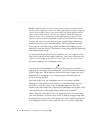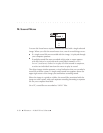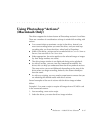
. . . . . . . . . . . . . . . . . . . . . . . . . . . . .
Reference — Kodak Driver Software 8-41
from the image information window, image naming data, image color
balance data, image cropping data, and image rotation data.
The Specifications appendix lists file sizes for these image files for your
camera.
IMPORTANT: Do not open image archive files (files that you create by copying
images to your computer hard disk with the C
OPY TO button) with Photoshop or
other image software and then resave the data with the same filename. The image
archive files you create with the C
OPY TO button contain several sections — one
section with a TIFF version of the thumbnail, and then another section with the
image data. When you open the file with Photoshop, only the TIFF thumbnail is
opened, and if saved, only the thumbnail is saved — not the image data. For this
reason, you should only open these files from within the driver image window
using the C
HOOSE FOLDER choice of the SOURCE menu as described in this chapter;
this ensures that you obtain the image data.
P. D ELETE Button
You click the DELETE button to delete selected images from their source —
either the camera or an image archive file. A dialog box warns you that
images will be deleted. Selected images include images you have clicked
that may have temporarily scrolled out of view in the image area of the
driver image window.
NOTES: The DELETE button on the camera back does not function when the
camera is connected to a computer; use this D
ELETE button on the software driver
image window to delete images in this configuration.
You may be able to recover images you delete with this button; refer to the
“Recover” button section of this chapter.


















